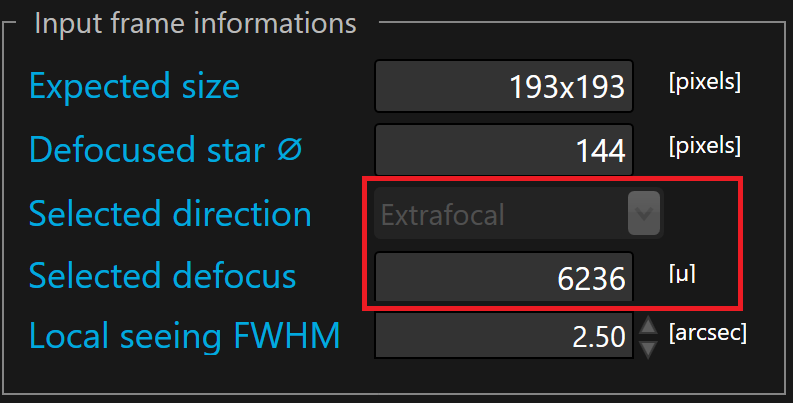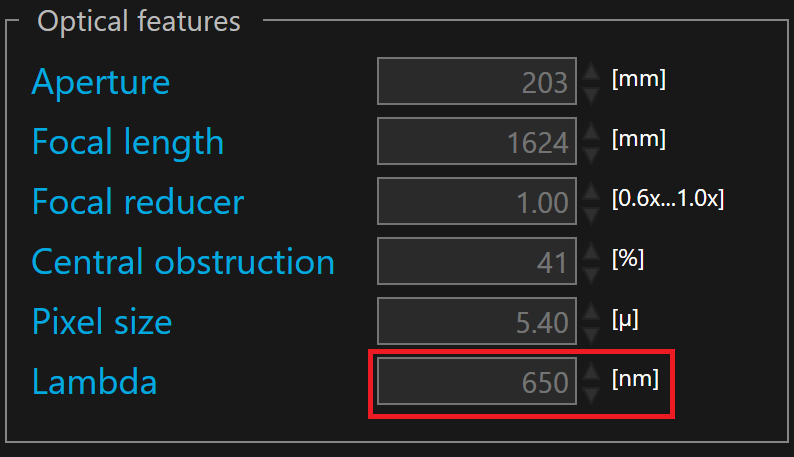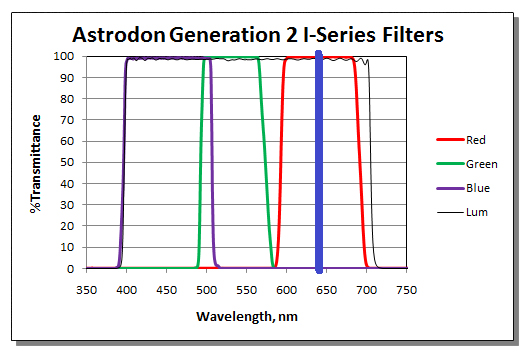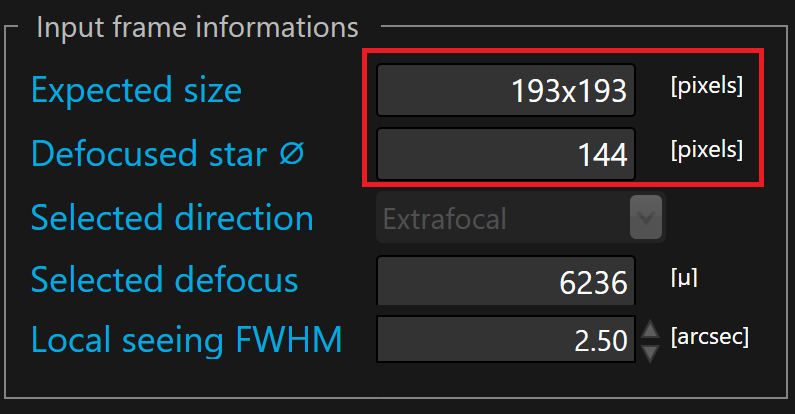How to capture a suitable defocused star
Procedure to capture a suitable deofucsed star that can be analyzed with SKW :
1. The imaging camera should be at best focus (use your usual focusing procedure to set the imaging camera to its best focus).
2. Set the exposure to time long enough, at least 10 seconds or more depending of your tracking performance, to average out the seeing.
3. Select a star such the defocused star signal level is between between an half to two thrid of the imaging camera sensor ADU scale, do not clip. The star should be located high enough to minimize seeing effects.
4. Defocus by the amount of the displayed selected defocus in micron toward the selected direction (see bellow in red). Be sure that defocused stars, if more than one, do not overlap each other. Leave some room, typically a defocused star diagonal apart.
If you do not have an external focuser using instead the primary or secondary mirrors for defocusing, or if your focuser does not have an accurate enough measurement, you can use the defocused star diameter displayed by SKW in the input frame information instead.

 If your focuser steps are not in microns you must convert the value in microns to steps and you must use the value in steps to defocus your telescope
If your focuser steps are not in microns you must convert the value in microns to steps and you must use the value in steps to defocus your telescope
5. Once properly defocused, if you use a monochrome camera with a filter wheel, we recommend that you select the red filter.
 Check if the middle of the filter bandwidth match the lambda (see below in red). If not you must disconnect SKW, adjust the lambda and connect SKW
Check if the middle of the filter bandwidth match the lambda (see below in red). If not you must disconnect SKW, adjust the lambda and connect SKW

 To know the middle of the filter bandwidth, you go to the manufacturer web site and get the middle of the filter bandwidth from the plot (see blue line on the following plot from Astrodon web site)
To know the middle of the filter bandwidth, you go to the manufacturer web site and get the middle of the filter bandwidth from the plot (see blue line on the following plot from Astrodon web site)

 You can take any filter to make the analysis, we generally recommend the red because it minimize the seeing. You can also use narrow band filters.
You can take any filter to make the analysis, we generally recommend the red because it minimize the seeing. You can also use narrow band filters.
 Narrowband Halpha filters provide accurate measure but requires longer exposure to get a good SNR on the defocused star. For telescope alignment a broadband color filter or even a luminance one are enough.
Narrowband Halpha filters provide accurate measure but requires longer exposure to get a good SNR on the defocused star. For telescope alignment a broadband color filter or even a luminance one are enough.
6. Once ready to capture, you should select a exposure time large enough to get good SNR. Typically at least 10 seconds, or is more as long as your tracking remains good during the exposure star (no elongated stars).
 Avoid saturation. If the selected star is too bright, you could select another one with higher magnitude or reducing the exposure time, the former option being the best.
Avoid saturation. If the selected star is too bright, you could select another one with higher magnitude or reducing the exposure time, the former option being the best.
7. Once captured, open the raw image in a FIT image viewer and check if the diameter is equal to the defocused star diameter (see below in red) and check if the frame surrounding the centered defocused star is equal or greater than the expected size (see bellow in red).

 SKW is tolerant if the defocused star diameter is a somewhat smaller and bigger than what SKW expects.
SKW is tolerant if the defocused star diameter is a somewhat smaller and bigger than what SKW expects.
 If defocusing is done by moving one mirror (primary or secondary), yous should do few iterations between moving focuser, capturing a frame and measuring each time if the captured diameter is close to the calculated diameter in pixels.
If defocusing is done by moving one mirror (primary or secondary), yous should do few iterations between moving focuser, capturing a frame and measuring each time if the captured diameter is close to the calculated diameter in pixels.
 The difference between the calculated and the captured star diameters can be explained by several causes :
The difference between the calculated and the captured star diameters can be explained by several causes :
|
Cause |
Solution |
|
The telescope was not defocused by the amount displayed by SKW |
Read the focuser manual to ensure what is the size of a focuser step in micron Check again the microns to step conversion. |
|
The telescope was not at his best focus before defocusing |
Redo the focus to restore your telescope at his best focus and defocus it again of the given value. |
6. Once the captured defocused star match the input frame informations you can load it, select it and analyze it